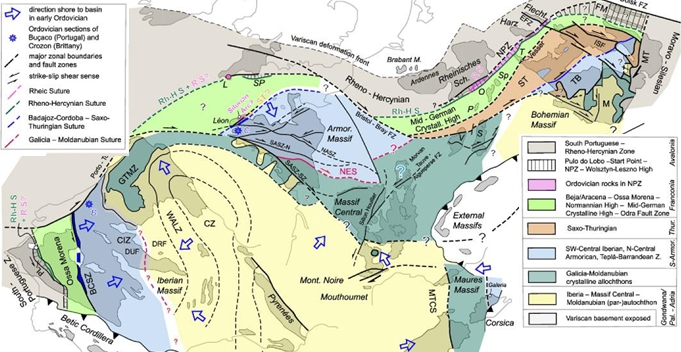
Gondwana Research 48 (2017) 257–284: Read Here
Wolfgang Franke, L. Robin M. Cocks, Trond H. Torsvik
The Variscan and related North American orogenies which now total 6,000 kilometres of strike, were caused by the opening and closing of the Rheic Ocean over a 100 million year period from 440MA to 320MA. This period saw the creation of several minor oceans and seaways, repeated periods of rifting and subduction and ultimately with the amalgamation of Laurussia and Gondwana, formation of the Pangea super-continent. Wolfgang Franks and colleagues have undertaken a comprehensive review and re-interpretation of the oceanic history of the Variscan domain. They attribute the complex geology to the opening and closing of 5 oceans or seaways, rifting and repeated subduction events. As a consequence of this complex tectonism, Variscan Europe is well endowed with mineral deposits although few are in production. Indeed this is where the industrial exploitation of Cu, Pb, Zn, Ag and Au commenced in post Roman times. The proposed complexity is very similar to that observed along the margins of the Tethyan Ocean to the east during a later period. This paper is well worth a detailed review.
In the comments below we summarize the Franks et al paper to produce a history of the Variscan.
A Brief History of the Variscan
Early Palaeozoic
- From at least Cambrian times the Armorican Terrane Assemblage (ATA) appears to have formed a promontory at the edge of the Gondwana Craton near NW Africa
- In the early Ordovician (~490MA) along the eastern side of Iapetus Ocean a rift developed along the NW flank of Gondwana forming the Rheic Ocean. A rifted Gondwana fragment Avalonia moved westwards towards Laurussia as the Rheic Ocean expanded at the expense of the Iapetus;
- The Rheic Ocean became very wide;
- Towards the end of the Ordovician Avalonia merged with Laurussia with much strike-slip faulting;
Silurian
- During the Late Silurian and Early Devonian NE subduction of the Rheic Ocean lead to back-arc spreading and sedimentation in what is now in part the Rheno-Hercynian belt
- Additional rifting in the Silurian (~440MA) along the NW margin of Africa resulted in the formation of the Saxo-Thuringian and the Galicia-Moldanubian seaways and the separation of the ATA elements from each other and ATA from Gondwana (with Palaeo-Adria to the immediate east).
Devonian
- The Saxo-Thuringian Ocean and ultimately, collision of the Thuringia and Franconia elements of the ATA with Avalonia previously accreted onto Laurussia (Baltica) occurred at ~ 400MA with the final closure of the NW extent of the Rheic Ocean;
- During the Devonian there was widespread strike-slip movement between ATA and Palaeo-Adria to the east possibly as consequence of east verging oblique subduction of the Saxo-Thuringian Ocean;
- In the Early Emsian, the Rheic mid-ocean ridge was subducted southwards under the northernmost part of the ATA (Franconia), creating the short-lived Baja California-type Rheno-Hercynian Ocean which incorporated the former back-arc basin sediments
- The northward and lateral movements of Gondwana saw the successive closure of the Galicia-Moldanubian, Saxo-Thuringian and Rheic Oceans from south to north, over the period from about 380Ma through the Early carboniferous
Carboniferous and Permian
- Laurussia and Gondwana finally collided at around 320MA to form the super-continent Pangea
- Prior to this collision there was significant dextral strike-slip movement between Laurussia and Gondwana
- Post collision, the Amorican terranes returned to roughly the same location prior to their separation more than 100 million years earlier;
- This collision produced a very extensive orogen extending from the Ouachita and the Alleghanian Orogenies in North America through the Variscan of Western Europe;
- Continued shortening into the Late Carboniferous saw dextral strike-slip faulting along the SW margin of Baltica and clockwise rotation of the Bohemian Arc into its current location
- This orogenesis extended from the Carboniferous into the Middle Permian with collisional shortening of more than 1,000 km.
Abstract
Geological evidence, supported by biogeographical data and in accord with palaeomagnetic constraints, indicates that “one ocean” models for the Variscides should be discarded, and confirms, instead, the existence of three Gondwana-derived microcontinents which were involved in the Variscan collision: Avalonia, North Armorica (Franconia and Thuringia subdivided by a failed Vesser Rift), and South Armorica (Central Iberia/Armorica/ Bohemia), all divided by small oceans. In addition, parts of south-eastern Europe, including Adria and Apulia, are combined here under the new name of Palaeo-Adria, which was also Peri-Gondwanan in the Early Palaeozoic. Oceanic separations were formed by the break-up of the northern Gondwana margin from the Late Cambrian onwards. Most of the oceans or seaways remained narrow, but – much like the Alpine Cenozoic oceans – gave birth to orogenic belts with HP-UHP metamorphism and extensive allochthons: the Saxo-Thuringian Ocean between North and South Armorica and the Galicia-Moldanubian Ocean between South Armorica and Palaeo-Adria. Only the Rheic Ocean between Avalonia and peri-Gondwana was wide enough to be unambiguously recorded by biogeography and palaeomagnetism, and its north-western arm closed before or during the Emsian in Europe. Ridge subduction under the northernmost part of Armorica in the Emsian created the narrow and short-lived Rheno-Hercynian Ocean. It is that ocean (and not the Rheic) whose opening and closure controlled the evolution of the Rheno-Hercynian fold-belt in south-west Iberia, south-west England, Germany, and Moravia (Czech Republic). Devonian magmatism and sedimentation set within belts of Early Variscan deformation and metamorphism are probably strike-slip-related. The first arrival of flysch on the forelands and/or the age of deformation of foreland sequences constrains the sequential closure of the Variscan seaways (Galicia-Moldanubian in the Givetian; Saxo-Thuringian in the Early Famennian; Rheno-Hercynian in the Tournaisian). Additional Mid- to Late Devonian and (partly) Early Carboniferous magmatism and extension in the Rheno-Hercynian, Saxo-Thuringian and Galicia-Moldanubian basins overlapped with Variscan geodynamics as strictly defined. The Early Carboniferous episode was the start of episodic anorogenic heating which lasted until the Permian and probably relates to Tethys rifting.
Gondwana Research 48 (2017) 257–284: Read Here
